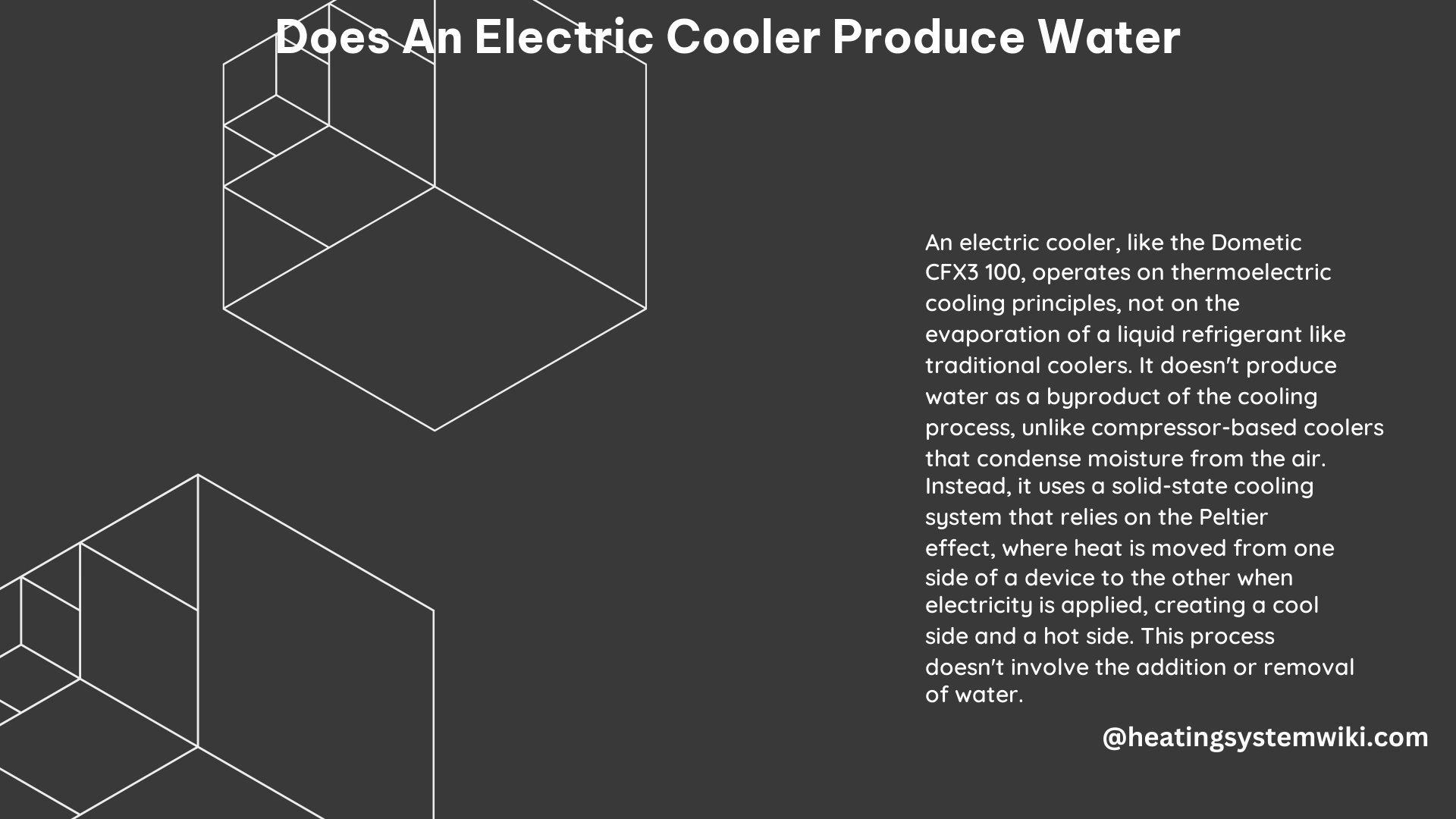An electric cooler, specifically a thermoelectric cooler, does not directly produce water as a byproduct of its cooling process. However, condensation can occur due to the interaction between the cooler’s cold surface and the surrounding humid air. This article will provide a comprehensive technical overview of how electric coolers work, the potential for water production, and practical considerations for managing condensation.
Understanding Thermoelectric Cooling
Thermoelectric coolers, also known as Peltier coolers, operate based on the Peltier effect. This phenomenon involves the transfer of heat from one side of a device to the other when a DC electric current flows through it. The “hot” side of the device is attached to a heat sink to maintain it at ambient temperature, while the “cold” side goes below room temperature.
The efficiency of the cooling process is directly related to the temperature difference between the desired (cold side) and ambient (hot side) temperatures. As the temperature difference increases, the cooling efficiency decreases. This is an important consideration when using thermoelectric coolers, as they are generally less efficient than traditional compressor-based refrigeration systems.
Key Specifications of Thermoelectric Coolers:
| Specification | Typical Range |
|---|---|
| Temperature Difference (ΔT) | 30°C to 70°C |
| Coefficient of Performance (COP) | 0.3 to 0.6 |
| Power Consumption | 10 to 200 watts |
| Cooling Capacity | 10 to 300 watts |
Thermoelectric coolers are used in a variety of applications, including:
- Consumer products: Camping/car electric coolers, wine coolers, and portable refrigerators
- Electronics cooling: Cooling of electronic components, such as CPUs, laser diodes, and fiber-optic devices
- Industrial applications: Thermoelectric air conditioners, laser equipment cooling, and temperature stabilization for sensitive equipment
Does an Electric Cooler Produce Water?

While thermoelectric coolers do not directly produce water as a byproduct of their cooling process, condensation can occur due to the interaction between the cold surface of the cooler and the surrounding humid air.
When the cold side of the thermoelectric cooler is exposed to humid air, the moisture in the air can condense on the surface, forming water droplets. This condensation is not a feature or intended outcome of the cooling process, but rather a result of the temperature difference between the cooler and the ambient air.
The amount of condensation produced will depend on several factors, including:
- Ambient humidity levels: Higher humidity levels will result in more condensation.
- Temperature difference: The greater the temperature difference between the cooler and the ambient air, the more condensation will occur.
- Airflow and ventilation: Proper airflow and ventilation can help reduce the buildup of humid air around the cooler.
Managing Condensation in Electric Coolers
To prevent or minimize the formation of condensation in an electric cooler, it is important to take the following measures:
-
Seal Potential Entry Points: Carefully seal any gaps or openings in the cooler’s housing to prevent humid air from entering the interior. This includes sealing around wires, cables, and other potential entry points.
-
Improve Airflow and Ventilation: Ensure that the cooler has adequate airflow and ventilation to prevent the buildup of humid air around the cold surface. This may involve the use of fans or vents to circulate the air.
-
Use Absorbent Materials: Incorporate absorbent materials, such as filter sponges or desiccant packs, inside the cooler to help absorb any condensation that does form.
-
Avoid Overloading: Do not overload the cooler, as this can restrict airflow and contribute to the formation of condensation.
-
Monitor and Maintain: Regularly check the cooler for signs of condensation and take appropriate action to address any issues that arise.
Limitations of Thermoelectric Cooling for Water Cooling
While thermoelectric coolers can be used for cooling water in certain applications, they are generally not recommended for use in water cooling loops. Thermoelectric devices are inherently inefficient, with a typical coefficient of performance (COP) ranging from 0.3 to 0.6.
Attempting to use a thermoelectric cooler to cool water in a loop would actually add more energy to the system than it would remove, resulting in a net increase in temperature rather than cooling. This is because the heat generated by the inefficient thermoelectric device would outweigh the cooling capacity.
Instead, it is recommended to use traditional water cooling solutions, such as those with fans running at low speeds, which are more efficient and practical for cooling water in a closed loop system.
Conclusion
In summary, an electric cooler, specifically a thermoelectric cooler, does not directly produce water as a byproduct of its cooling process. However, condensation can occur due to the interaction between the cooler’s cold surface and the surrounding humid air. To manage this condensation, it is important to seal potential entry points, improve airflow and ventilation, use absorbent materials, and monitor the cooler regularly.
While thermoelectric coolers have their applications, they are generally not recommended for use in water cooling loops due to their inherent inefficiency. Traditional water cooling solutions are more efficient and practical for this purpose.
References:
– Thermoelectric Coolers – Energy.gov
– Thermoelectric Cooling – Wikipedia
– Dometic CFX3 100 Electric Cooler Review
– How to Prevent Condensation on Peltier TEC Cooler
– Using Peltier Modules to Cool Water Down
